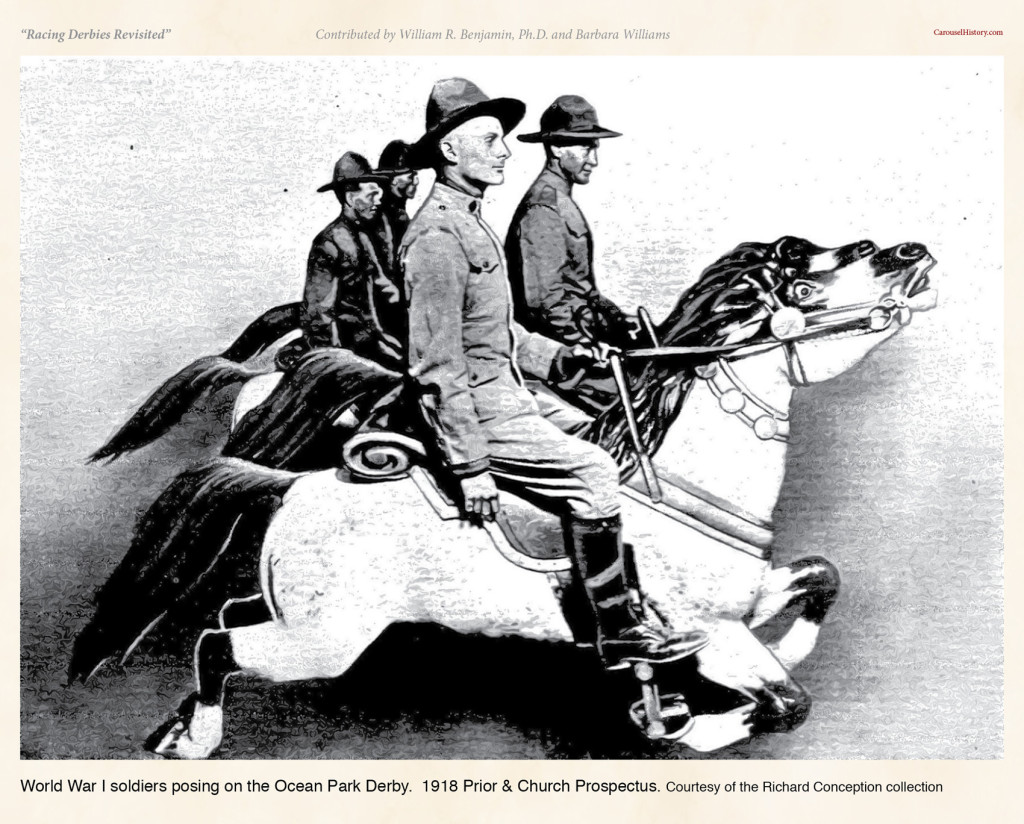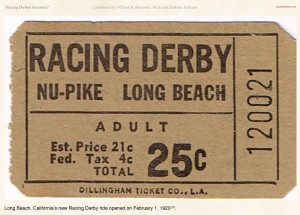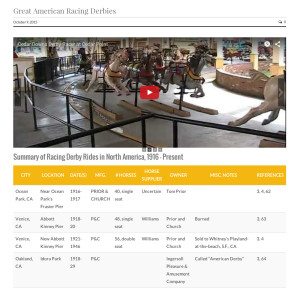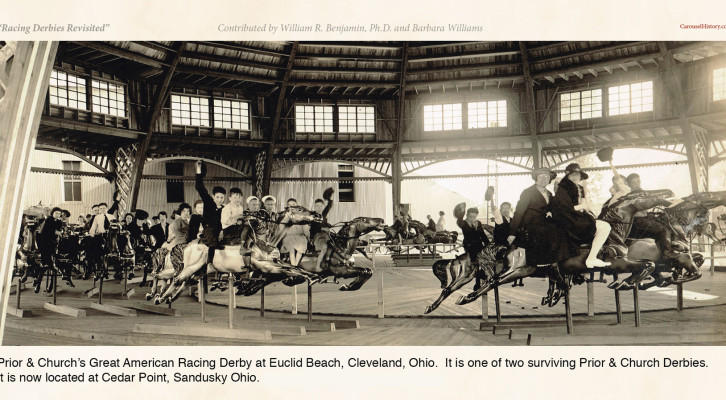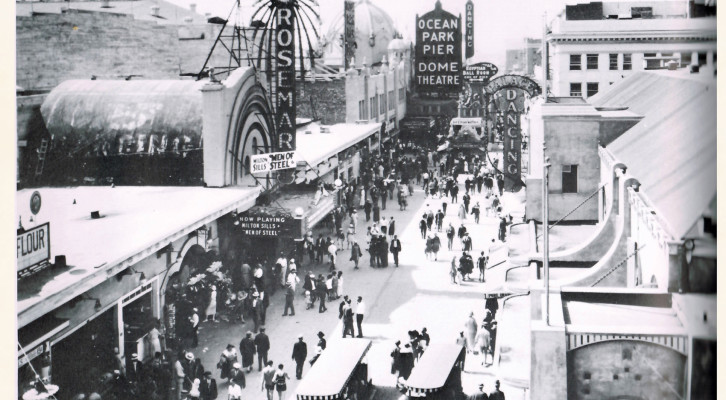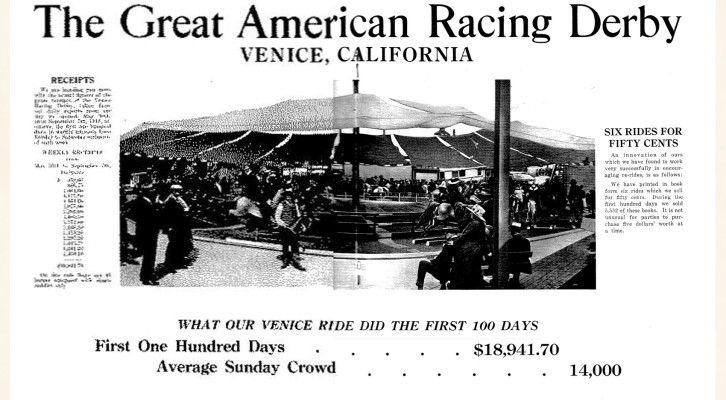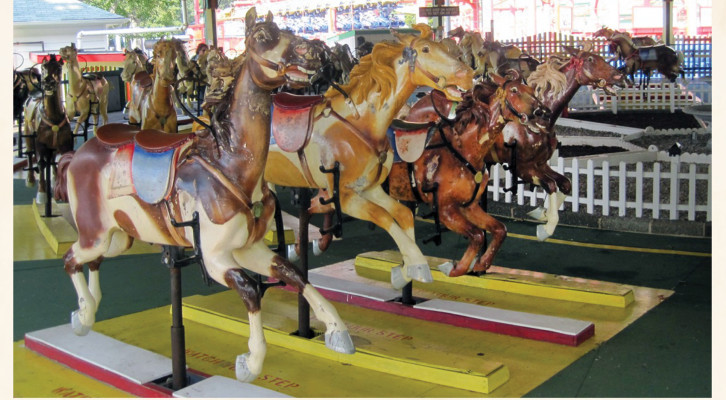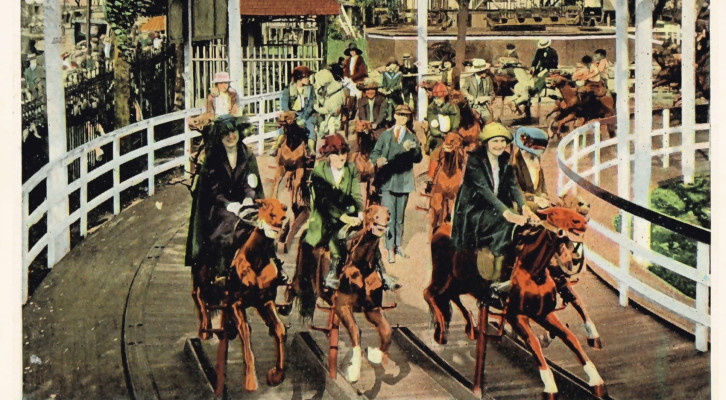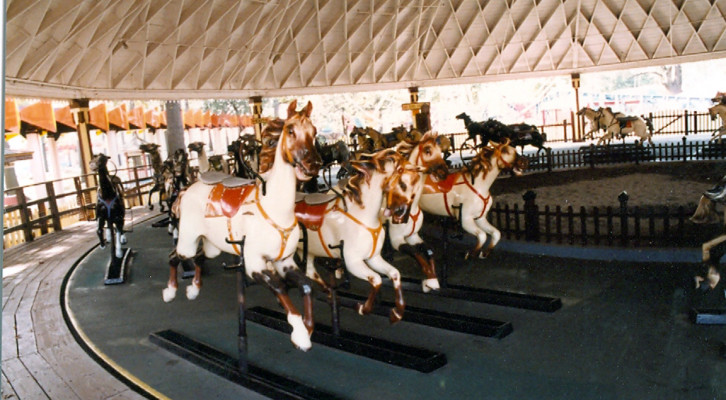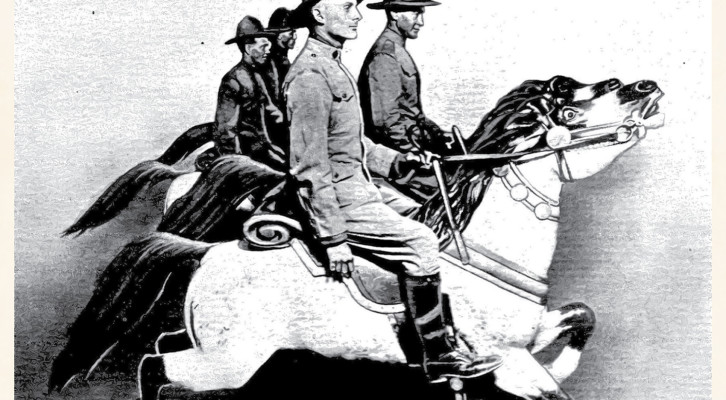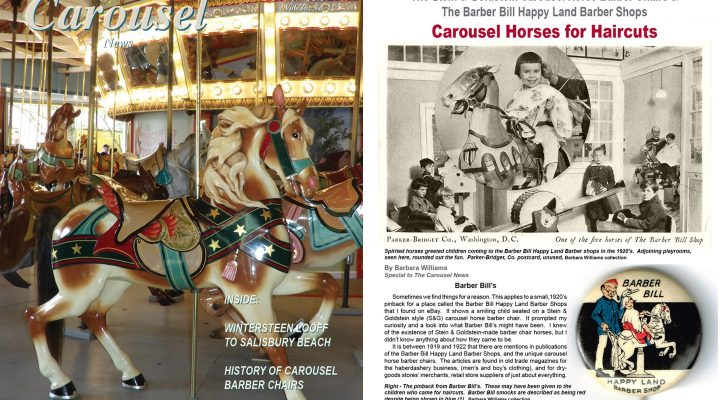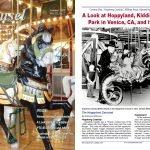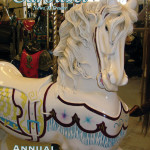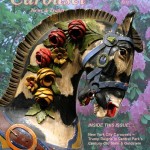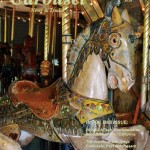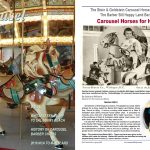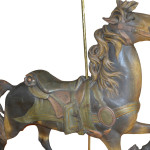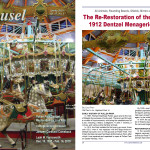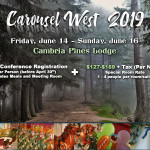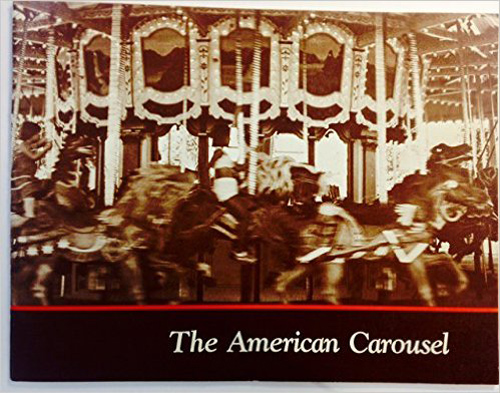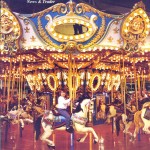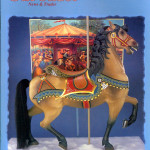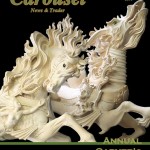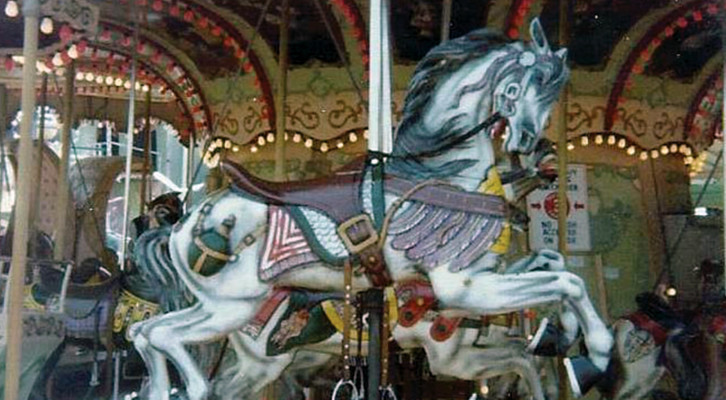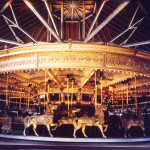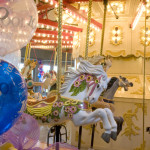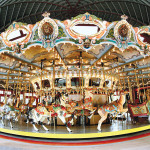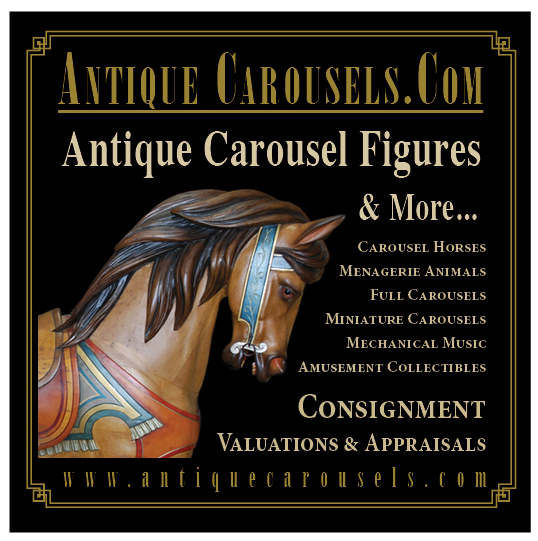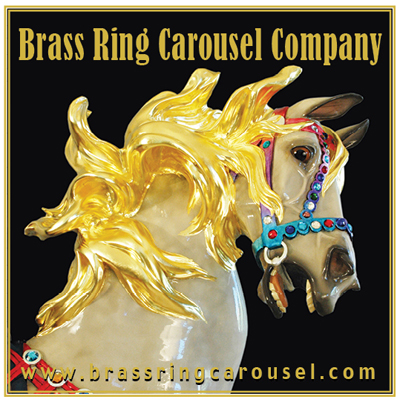Racing Derbies Revisited – Part 6
R. C Williams, Illions; Derby Horses – Styles and Manufacturers, Summary of Derby Rides
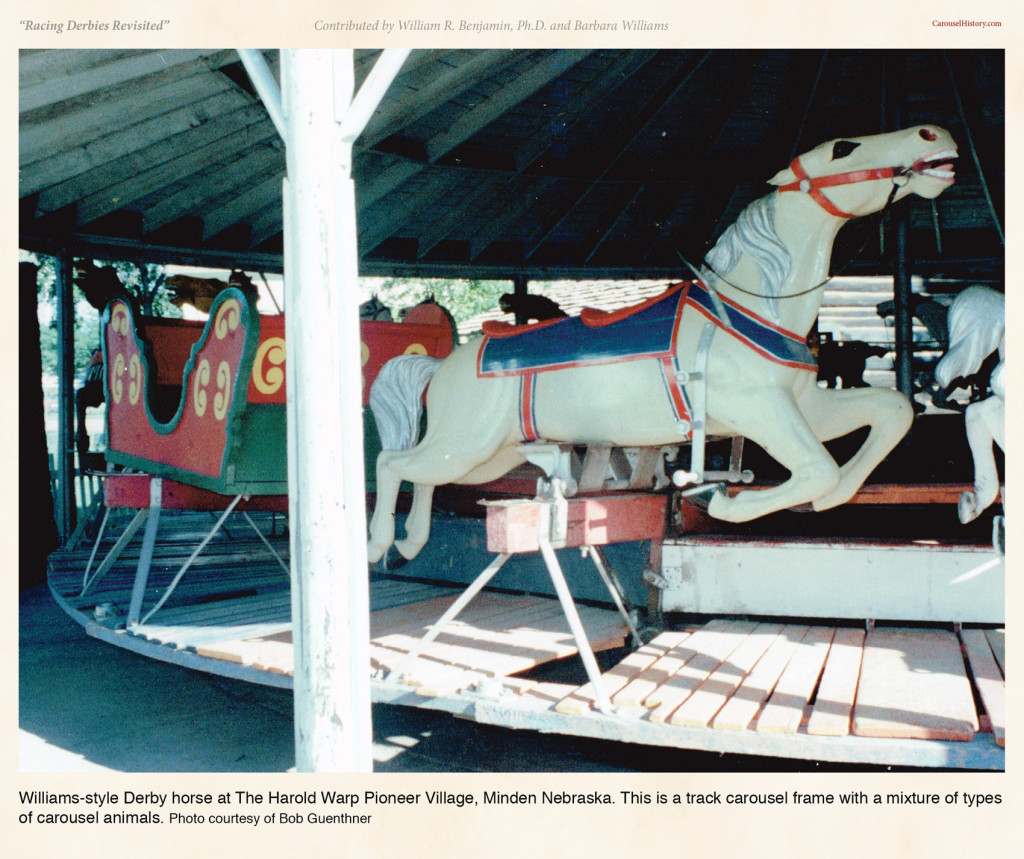
Williams-style Derby horse at The Harold Warp Pioneer Village, Minden Nebraska. This is a track carousel frame with a mixture of types of carousel animals.
R. C. Williams Amusement Company
The majority of the horses on Prior & Church’s Great American Racing Derby rides are of one style. They are recognizable as having a Parker-like look with similar faces, manes and tails.
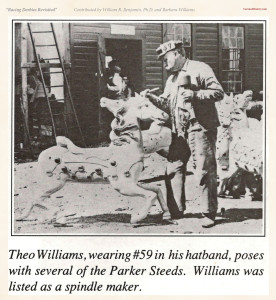 A carver named Theophilus (Theo) Williams (b. 1850) was employed at the Parker factory. Prior to working for Parker, Theo and his family, including a son, Royale (b. 1886, d. 1972), lived in Chicago according to his 1910 Census record. Theo’s occupation was listed as “Woodwork Manufacturing”. In 1915, Theo went into business for himself as the R.C. Amusement Company in Denver, CO. In the 1920 Census, Theo is living in Denver, CO. His occupation is listed as “wood carver”. Royale’s WWI draft registration lists him as being a “Machinist”. Royale is listed as
A carver named Theophilus (Theo) Williams (b. 1850) was employed at the Parker factory. Prior to working for Parker, Theo and his family, including a son, Royale (b. 1886, d. 1972), lived in Chicago according to his 1910 Census record. Theo’s occupation was listed as “Woodwork Manufacturing”. In 1915, Theo went into business for himself as the R.C. Amusement Company in Denver, CO. In the 1920 Census, Theo is living in Denver, CO. His occupation is listed as “wood carver”. Royale’s WWI draft registration lists him as being a “Machinist”. Royale is listed as 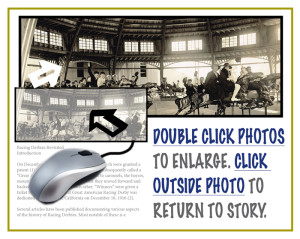 “Manager Amusements Manufacturing” in Denver in the 1930 census. Additionally, Jim Abbate’s research indicates there was a Theo Williams from Camden, NJ who went to Denver but it isn’t clear if this is the same person as from Chicago. The shop is said to have made thousands of horses with elongated bodies that were mostly used on Prior & Church racing derbies. Additionally, they were shipped to Mexico, Cuba, England and France (60). The shop had twenty five to thirty employees(60). A carver for the Williams Amusement & Device Company named Loren White is listed in the 1923 Corbett & Ballenger’s 51st Annual Denver Directory. An employee, Max Bisgard, no occupation given, is listed in the 1920 directory (61).
“Manager Amusements Manufacturing” in Denver in the 1930 census. Additionally, Jim Abbate’s research indicates there was a Theo Williams from Camden, NJ who went to Denver but it isn’t clear if this is the same person as from Chicago. The shop is said to have made thousands of horses with elongated bodies that were mostly used on Prior & Church racing derbies. Additionally, they were shipped to Mexico, Cuba, England and France (60). The shop had twenty five to thirty employees(60). A carver for the Williams Amusement & Device Company named Loren White is listed in the 1923 Corbett & Ballenger’s 51st Annual Denver Directory. An employee, Max Bisgard, no occupation given, is listed in the 1920 directory (61).
Illions…
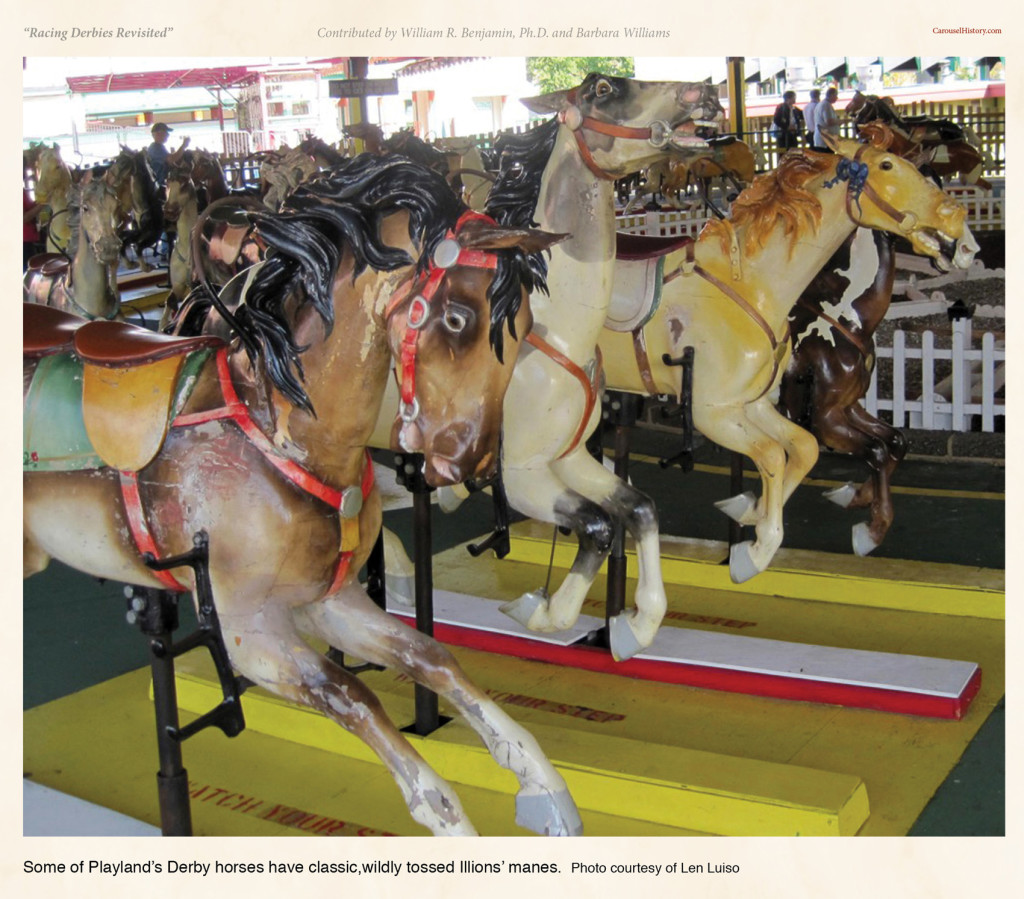
Some of Playland’s Derby horses have classic,wildly tossed Illions’ manes. Photo courtesy of Len Luiso
M. C. Illions & Sons
The Ilions Derby horses are clearly the work of M.C. Illions. Even the bodies have the same characteristics despite being somewhat simplified and elongated.
Others…
A Different Style
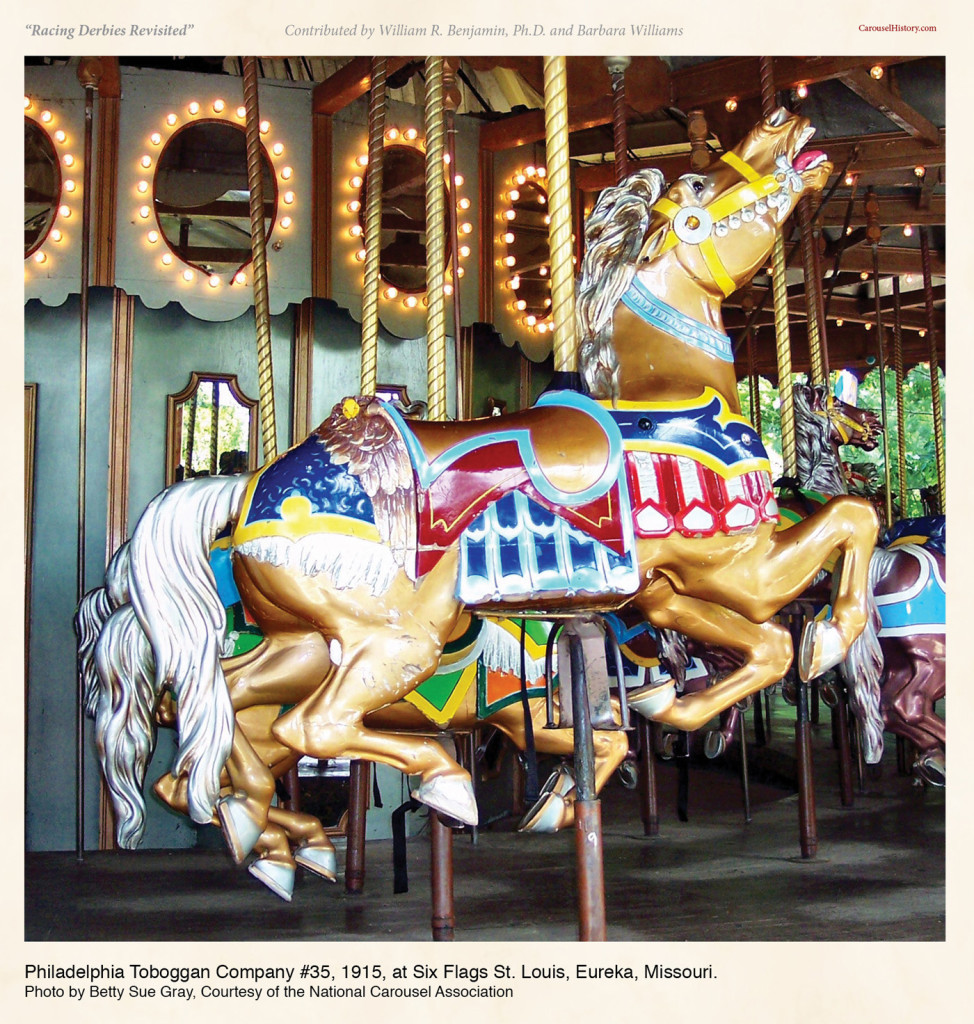
Philadelphia Toboggan Company #35, 1915, at Six Flags St. Louis, Eureka, Missouri. Photo by Betty Sue Gray, Courtesy of the National Carousel Association
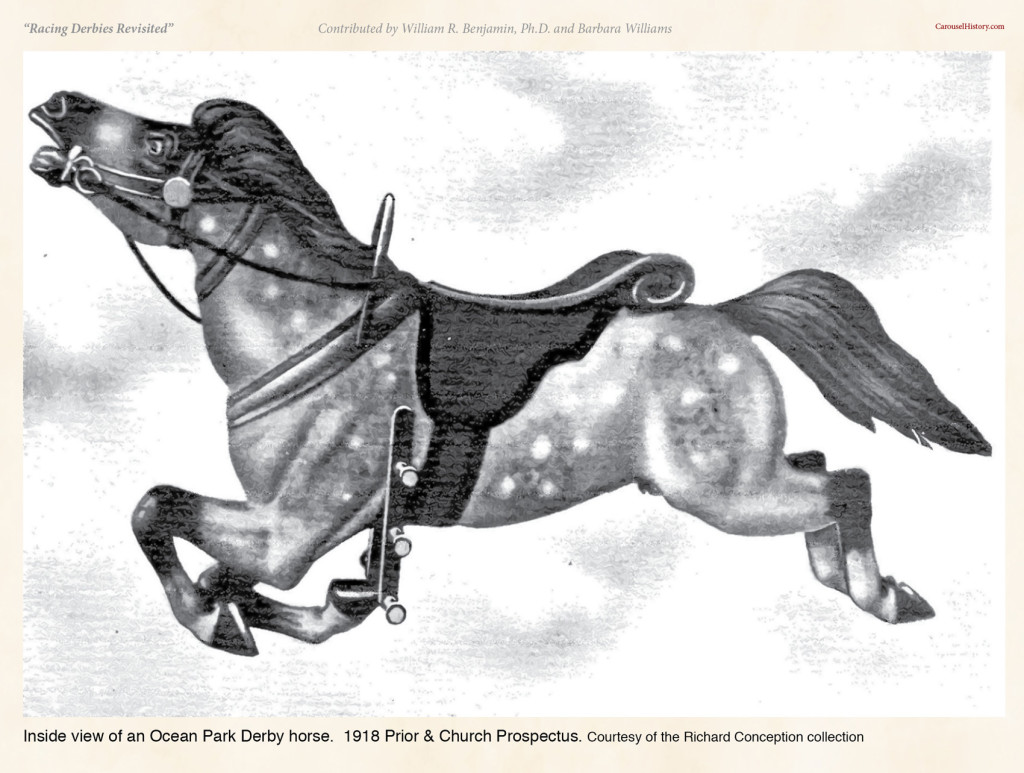
Inside view of an Ocean Park Derby horse. 1918 Prior & Church Prospectus.Courtesy of the Richard Conception collection
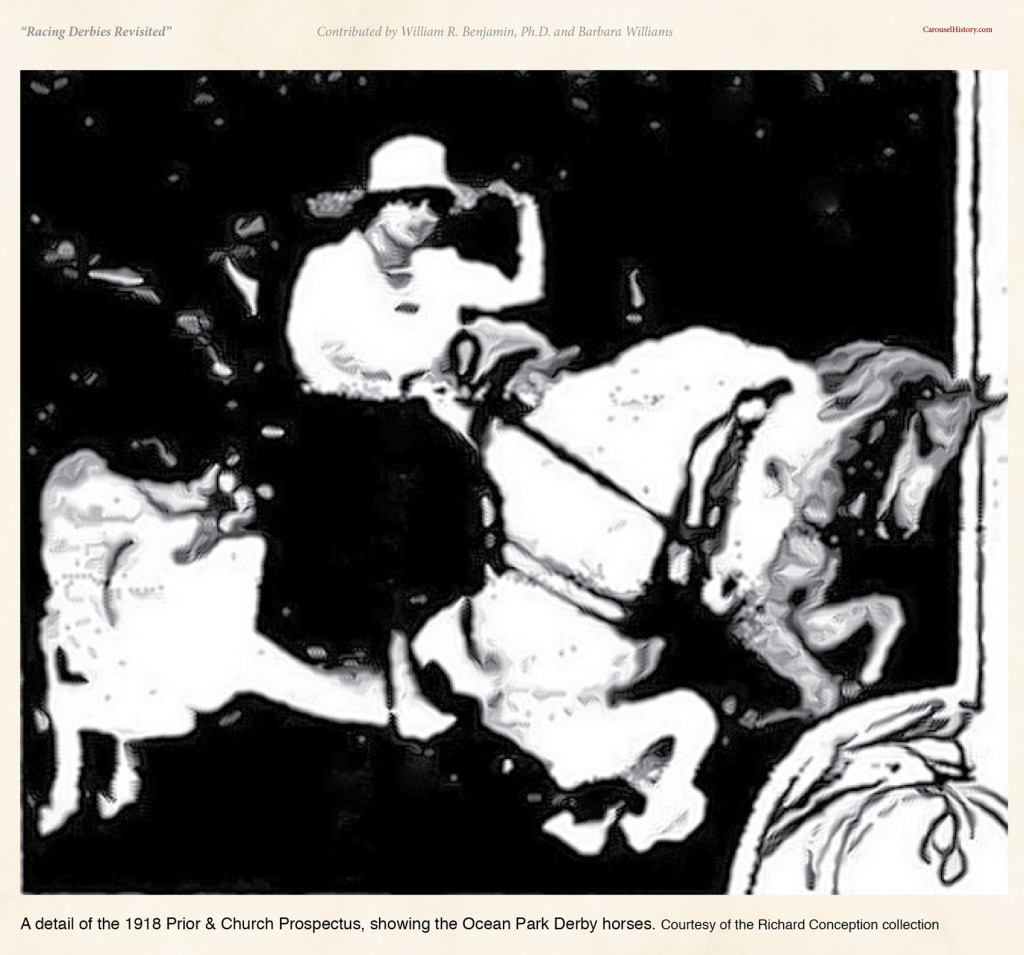
A detail of the 1918 Prior & Church Prospectus, showing the Ocean Park Derby horses. Courtesy of the Richard Conception collection

Above Left – Close up of a closed-mouth Ocean Park Derby horse. Right – Zalar Looff, 1916, Belmont Park, San Diego, California in 1974. Zalar worked for both Looff and PTC. Zalar’s Looffs and PTCs had very similar looks.
The Ocean Park Derby horses are a different style. They are not the style of M.C. Illions nor are they the Williams/Parker style. In looking at different carousel horses, one company’s seemed to stand out as resembling the horses on the Ocean Park Derby. We couldn’t help but notice a sameness between some Philadelphia Toboggan Company horses and the Ocean Park horses. While not identical, they have features that are similar. More similar, perhaps, when compared to other manufacturers’ horses.
An Additional Style
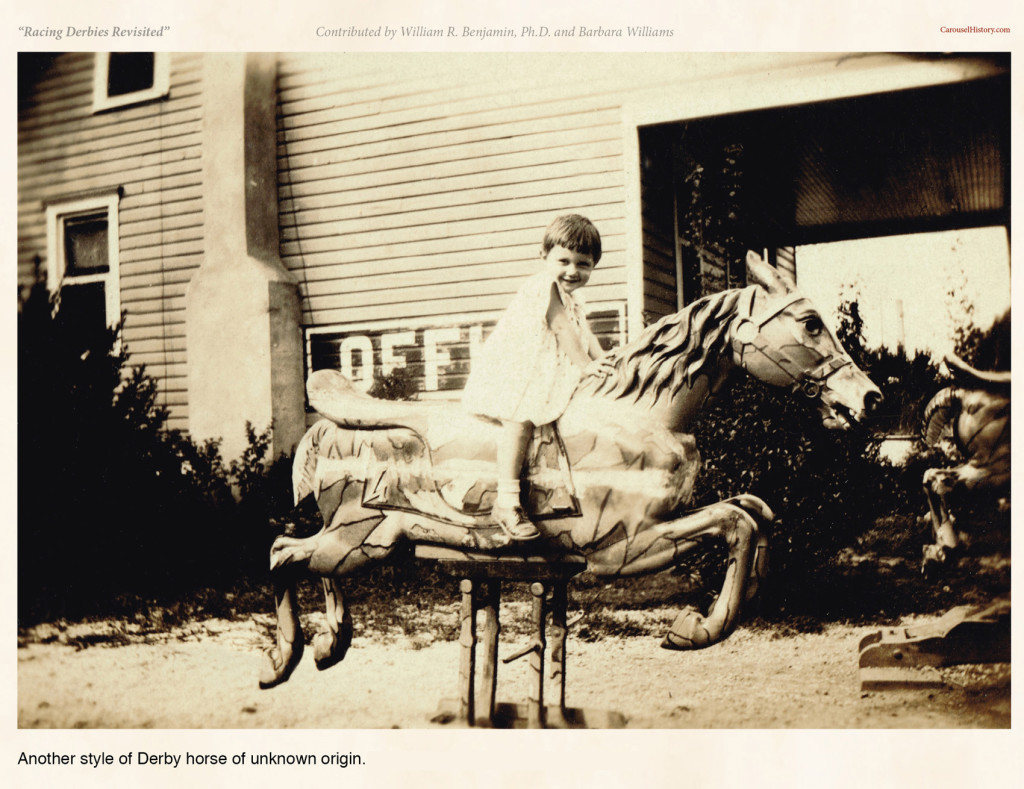
This snapshot was purchased in Pennsylvania. It shows a 2-seater Derby horse with a carved bridle, saddle and a blanket. It is second additional Derby style not directly associated with a particular maker.
A picture of yet another style of Derby horse turned up as this article was in the process of completion. There is no information written on the picture. The Ebay seller is in Pennsylvania where he bought it at a flea market.
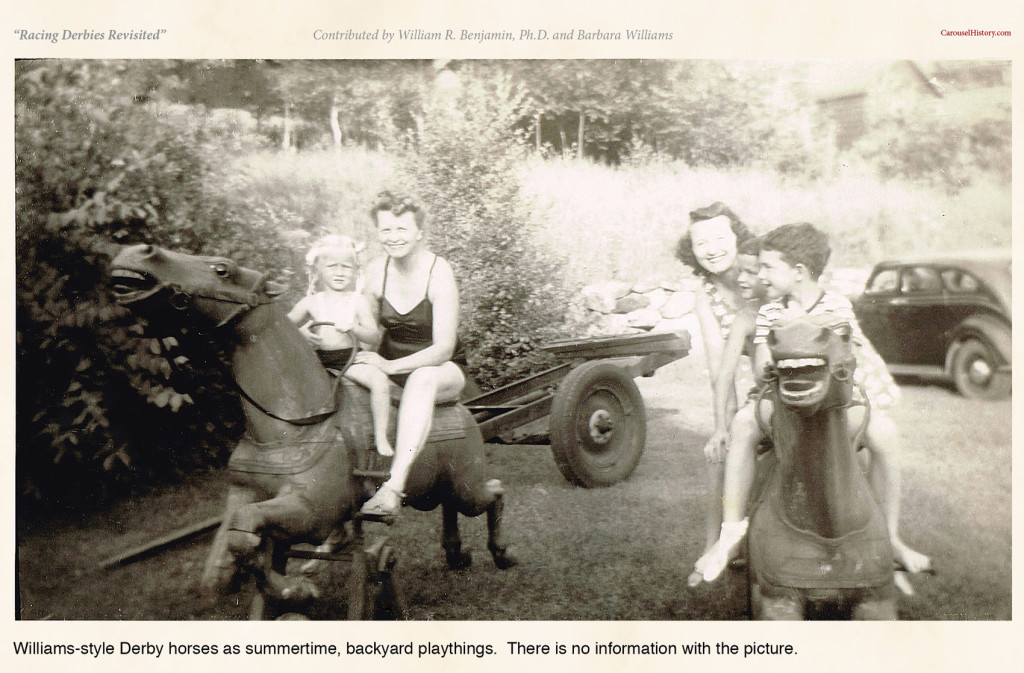
Williams-style Derby horses as summertime, backyard playthings. There is no information with the picture.
Conflicts
Jeff Stanton’s research (no citation given) indicates the horses for the Ocean Park Derby were ordered from Parker and there was a delay due to a factory backlog, postponing the ride’s debut from July 4, 1916 to February 4, 1917 (4).Our research shows the actual date of the opening as being December 10, 1916 which is confirmed by several newspaper accounts of events leading up to, during and after the grand opening of the Derby.
Additionally, the Parker information does not seem to fit the appearance of the horses, but it can only be speculative to think that PTC might have made them for Ocean Park’s Derby. By studying the features of the Derby horses, we hope readers will make their own observations.
The conflicts are a reminder of the need to heed caution when researching history and relying on previously documented information.
Conclusions
The invention and development of the Great American Racing Derby by Tom Prior and Frank Church, in many ways, seems to have been a natural evolution of amusement rides combining elements of carousels and steeplechase rides and bringing in the excitement of horse racing, including the hope of “winning” a free ride. When first manufactured, Prior claimed “This ride is going into every amusement park and city in America”. Claims of large weekly receipts and a high percentage of re-rides show the huge popularity of the rides. At least 18 were installed between late 1916 and 1921.
However, we found a number of instances where announcements were made that rides would be installed but found no evidence that they actually were. These rides seemed not to be as safe as carousel rides based on the number of articles that we discovered concerning lawsuits resulting from injuries. The time between the first and last installation of new Racing Derbies spanned about 11 years, ending in about 1927. Did the novelty wear off? Were the economic costs too high? Were they considered to be too dangerous? Or did Prior and Church simply decide that there wasn’t sufficient interest in them to justify continued production?
Another unanswered question concerns the manufacturers of the horses, in particular the manufacturer of the ones with PTC-like features.
We hope that the research that we’ve presented will allow additional information about the Racing Derbies to be discovered.
Summary of Racing Derbies
Racing Derbies Revisited….
Contributed by William R. Benjamin, Ph.D. and Barbara Williams
<<< PREVIOUS – NEXT >>>
PART 1 – PART 2 – PART 3 –
PART 4 – PART 5 – PART 6 –
SUMMARY OF RIDES
<<< PREV – PART 1 – PART 2 – PART 3 – PART 4 – PART 5 – PART 6 – RIDES – NEXT >>>
Racing Derbies Revisited –
References
- Merry-Go-Round, United States patent number 1,082,764, Thomas W. Prior and Frederick A. Church, December 30, 1913
- Young Jockeys Enjoy the Great Racing Derby, December 11, 1916, Santa Monica Evening Outlook, Santa Monica Public Library
- Jim Abbate, 2012. Great American Racing Derby, NAPHA(National Amusement Park Historical Association)News, Volume 34, #1
- Jeffrey Stanton, 1997, The Great American Racing Derbys, excerpt from Venice, California – Coney Island of the Pacific, The Carousels of the Santa Monica Bay, The Merry-Go-Roundup, Volume 24 #2
- From Ancestry.com
- Obituary, September 27, 1918, Chicago Daily Tribune
- Music and Drama, Chicago Daily Tribune, August 12, 1892
- Manager at Trocadero Thursday, August 20, 1893, Chicago Daily Tribune
- A New Music Hall, November 10, 1891, Chicago Daily Inter Ocean
- Stranded, December 29, 1892, Lima News
- Music and Drama, February 3, 1893, Chicago Daily Tribune
- Advertisement, April 14, 1895, Chicago Daily Tribune
- South Side Amusement Place, February 5, 1896, Chicago Daily Tribune
- Crash Opens the White City, May 20, 1906, Chicago Daily Tribune
- Riverview Park, May 31, 1907, Suburbanite Economist, Chicago
- Eaglets,January 25, 1908, Chicago Eagle
- Sanction Forest Park Sale, October 19, 1910, Chicago Daily Tribune
- Rush to Start New Suits; Nearly 200 Filed in Day, August 1, 1909, Chicago Daily Tribune
- Petitions in Bankruptcy, November 11, 1915, Chicago Daily Tribune
- Local Man Beats Eli Whitney, November 5, 1901, Chicago Daily Tribune
- United States patent number 611272A, Mathew Prior and Thomas W. Prior, September 27, 1898
- 1910 United States Census
- http://www.westland.net/venicehistory/articles/church.htm
- http://www.coastergallery.com/Manufacturer/Frederick_Church.html
- CA Death Index
- A. Church is Back From Eastern Visit, Santa Monica Evening Outlook, September 29, 1920, Santa Monica Public Library
- http://www.westland.net/venicehistory/articles/church.htm
- Great Racing Derby for the South Side, April 8, 1916, Santa Monica Evening Outlook
- Racing Derby to be Gem ofBeach, Santa Monica Evening Outlook, May 9, 1916, Santa Monica Public Library
- Names of Streets are Changed (Santa Monica commissioners meeting),February 23, 1917, Santa Monica Evening Outlook, Santa Monica Public Library
- The New Rosemary at Ocean Park is Artistic Gem,Santa Monica Evening Outlook, July 3, 1919, Santa Monica Public Library.
- http://www.betsysellsvenice.com/venice-history/
- http://www.casadetinaatvenicebeach.com/About-Venice-Beach.html
- American Racing Derby to be Put in at Venice, Santa Monica Evening Outlook, September 29, 1917, Santa Monica Public Library
- Fire Wipes out Famous Venice Pier, December, 22, 1920, The Oregon Daily Journal
- Venice Sure to Rebuild Rapidly Now, January 10, 1921, Santa Monica Evening Outlook, Santa Monica Public Library
- Fire Hits Abandoned Historic Venice Pier, December 14, 1946, The Billboard
- George Whitney’s Playland Hasn’t Closed a Single Day in 19 Years Operation, November 29, 1947, The Billboard
- The Great American Racing Derby prospectus, Cameo Productions, 1987; from Richard Concepcion collection and Bill Benjamin(Penn StateUniversity, Special Collections Library)
- Mike Winslow, http://mksgrist.wix.com/playlandatthebeach#!rides/ck64
- May 23, 1920, The Houston Post
- Galveston Bids You Welcome, November 16, 1920, The Houston Post
- Commercial Body Hears Port Needs, April 22, 1921, The Galveston Daily News
- Offer Amusement Features, May 1, 1921, The Waco News-Tribune
- April 10, 1928, The Galveston Daily News
- Children’s Day at Galveston Beach, June 25, 1925, The Galveston Daily News
- Galveston Children Crowd Beach for First Kid’s Day, June 7, 1928, The Galveston Daily News
- Attempt to Burn is a Failure, April 18, 1934, The Galveston Daily News
- Christie Mitchell. The Beachcomber. August 16, 1959,The Galveston Daily News
- Hygienic Horses, October 3, 1891, Scientific American
- http://www.winningponies.com/horse-racing-history.html
- Golden Age of Roller Coasters in Vintage Postcards, David W. and Diane De Mali Francis, 2003, Arcadia Publishing
- http://rcdb.com/3103.htm
- Painted Ponies, 1990, Bill Manns, Peggy Shank, Marianne Stevens, Zon Publishing
- Personal communication from Rol and Jo Summit
- http://www.westland.net/coneyisland/articles/independentrides.htm
- Inspect Coney’s ‘Jockey Ride’to Determine Safety – Building Dept. Acts After Three are Hurt – License is Suspended, August 13, 1928, The Brooklyn Daily Eagle
- Hurt When Wooden Horse Threw Them so Sue for $60,000, October 5, 1932, The Brooklyn Daily Eagle
- Pair Wins $18,500 for Injury on Coney Mechanical Horse, September 6, 1932, The Brooklyn Daily Eagle
- http://www.chasingmerrygorounds.com/Spring08lrNewsletter.pdf – Colorado Carousel Society – Williams Mfg. Co.
- http://digital.denverlibrary.org/cdm/search/searchterm/williams%20amusement%20company/order/nosort
- Dedicate “Derby”, December 15, 1916, Santa Ana Register
- Fire Wipes Out Famous Venice Pier, December 22, 1920, The Oregon Daily Journal
- Amusements, March 23, 1918, Oakland Tribune
- Amusements and Privileges at Parks, Piers and Beaches, December 27, 1919, The Billboard
- Territorial Rights. Great American Racing Derby, July 17, 1920, The Billboard
- Advertisement, June 27, 1920, Chicago Daily Tribune
- Advertisement, May 9, 1920, Chicago Daily Tribune
- Advertisement, July 10, 1921, Boston Post
- Great American Racing Derby, December 18, 1920, The Billboard
- http://cedarpoint.com
- http://ryeplayland.org
Acknowledgements
We express our sincere gratitude to the many individuals that shared photographs and documents from their collections and allowed us to present them in this article including Jim Abbate, Richard Conception, Bob Guenther, Len Luiso, Jeffrey Stanton, and Rol and Jo Summit. We also appreciate The Penn State Special Collections Library; Charles and Betty Jacques amusement park collection, The Special Collections, Rosenberg Library, Galveston, Texas, and the National Carousel Association for permission to print images from their collections. Jordan Williams for Photoshopping assistance. Finally, we are grateful for the availability of the Carousel History website developed by Roland Hopkins. In no other setting would we have been able to include a total of 45 illustrations to augment the historical text.
Photographs without attribution are from the Barbara Williams collection.

